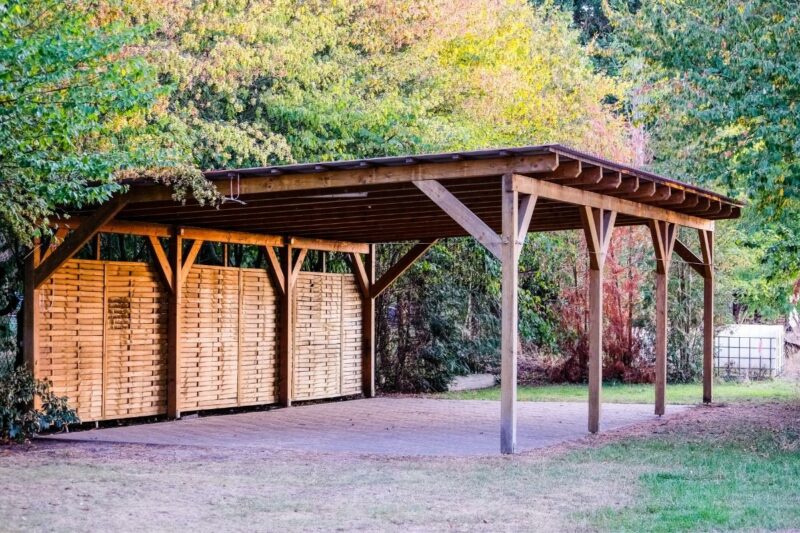Table of Contents Show
There are many things to consider when purchasing an RV, and storage is vital. Covered RV storage can be an essential investment for your RV. It protects your RV from the elements so that you don’t have to worry about incurring damage when your RV is sitting outside.
In this article, we’ll look at why covered storage is worth it, how much it costs, as well as the different types of storage available for the long term. Let’s get started!
What Is Covered RV Storage?
Covered RV storage is when you put your RV under a structure with a roof to keep it out of the elements.
Storing your RV in a sheltered place can prolong its life and prevent maintenance incurred by sun, rain, wind, or snow.
While fabric or vinyl RV covers are adequate for RV storage, they don’t compare to a solid, climate-controlled structure that offers good ventilation.

Types of Covered RV Storage
There are three main types of covered RV storage. Let’s take a look at them.
Outdoor Shelter
An outdoor shelter can come in various sizes and shapes. ShelterLogic is an excellent place to get outdoor RV shelters. Their wind and snow resistant garages are perfect for cold climates or locations subject to extreme elements.
Indoor and Climate-Controlled Storage
Indoor-covered RV storage is the best way to keep your RV protected when not in use.
A climate-controlled facility gives it even more protection against freezing temperatures, humidity, or excessive heat, all of which have the potential of damaging your RV or its systems.
You can find indoor and climate-controlled storage to rent throughout the country.
At-Home Garage or RV Port
The most convenient RV storage option is on your property. This is an ideal setup if you have a garage large enough to store your RV.
You might consider adding an RV port as an attachment to your house or a separate structure. As a carport, RV ports can be a cost-effective way to store your RV rather than paying for storage elsewhere.

Pro Tip: Have you heard of an RV Port Home? They can help you find a balance between road life and a traditional residence.
How Much Does Covered RV Storage Cost?
Covered storage rentals range on average from $150-$450 per month. The cost will depend on the location, whether it’s just a roof or an enclosed climate-controlled space.
Like we said previously, purchasing an RV port or storing your RV in a home garage will be more cost-effective in the long term. If you have the space for an RV port, the price will depend on your contractor and materials.
You can also opt for an outdoor shelter from a place like ShelterLogic, which will run you around $2,000.
What Are the Benefits of Covered RV Storage?
Covered RV storage prolongs the life of your RV and can reduce maintenance fees due to letting it sit out in the elements.
Three primary benefits include weather protection, climate control, and convenience. Let’s take a closer look at each.
Weather Protection
Protecting your RV from the weather may sound like a contradiction since you use your RV outdoors. However, constant exposure to wind, rain, snow, and the sun can damage the exterior of your RV.
For these reasons, covered RV storage is ideal when your RV is not in use.

Climate Controlled Options
Extreme temperatures can wreak havoc on your plumbing or produce mold or mildew on the interior. A climate-controlled storage facility can prevent this from occurring, which in turn helps prolong the life of your RV.
It also provides a healthier living environment when you take your RV out for a trip.
Ease of Use
Having covered RV storage is much more convenient than outdoor storage. You can quickly move your RV in and out without having to do much prep.
If you store your RV in a climate-controlled facility, you may not have to winterize when not using it for an entire season.
What Are the Disadvantages of Covered RV Storage?
The pros outweigh the cons of covered RV storage, in our opinion. However, two disadvantages are worth noting.
Cost
Covered RV storage is more expensive than outdoor storage. The cost may be prohibitive for some.
If that’s the case for you, we encourage you to look into an at-home RV port. They may cost a lot upfront, but they are a good investment for the long term.
You can choose from moveable options if you need to take it down or transport it to a new location.
Inconvenient Storage Locations
Most cities have RV storage options for rent nearby. However, they’re often full and therefore may not be easy to find close to your home.
If you use your RV regularly, storing it more than 10 miles from your house can be inconvenient. We recommend looking for storage well before you need it and getting on waiting lists if nothing is available.
Covered Storage vs. RV Cover: Which Is Better?
An RV cover is a great, economical option, but covered RV storage is the best choice if you can afford it and find it. Keeping your RV as well-protected as possible from sun damage or water is vital.
Delamination or problems with the RVs internal systems are more likely to occur when stored under a fabric or vinyl cover. Also, a cover can tear or not be as UV-protected as the manufacturer claims.

Pro Tip: Take a closer look at RV covers and when they might be the best investment for you.
Is Covered RV Storage Worth It?
We think covered RV storage is worth it. It comes at a higher price tag than an RV cover, but the long-term effects make it the ideal solution.
However, if you can’t afford covered storage, an RV cover is the next best thing. Whatever you decide, try to preserve your RV when it’s not in use so that you can enjoy it for years to come.
How do you cover your RV?






